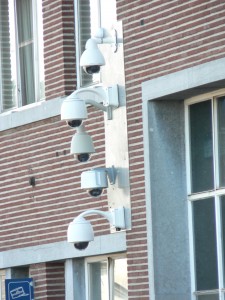Evolution of Video Surveillance Systems

The video surveillance industry is over 35 years old. It has evolved from using pure analog surveillance cameras and recording devices, which recorded videos on tape through VCR’s (videocassette recorders), to fully digital network based video surveillance systems which use high quality, high definition, network cameras to record and store videos on servers, clouds, or DVRs (digital video recorders). This change has had a deep impact on video forensics. The reasons that led to this evolution are improving computer and camera technology along with an ever increasing demand for better surveillance systems. However, in between the analog and network based digital surveillance systems exist the hybrid systems that are being used. This post will discuss the defining features of prominent video surveillance systems and outline the evolution of the modern day video surveillance industry.
Some reasons which led to improvement in Video Surveillance techniques are:
- Better image quality
- Simplified installation and maintenance
- More secure and reliable technology
- Longer retention of recorded video
- Reduction in costs
- Size and scalability
- Remote monitoring capabilities
- Integration with other systems, and
- More built-in system intelligence.
VCR Based Analog CCTV Surveillance Systems
Traditional VCR based analog CCTV surveillance systems used black and white analog CCTV cameras to capture videos. These analog cameras were typically connected to the VCR through a coaxial cable. The VCR recorded videos on the same VHS cassettes which were used in a home VCR (remember Blockbuster Video?). There were many problems with these cassettes, one of the largest being that they couldn’t store more than 8 hours of video and thus needed either regular replacement or constant reuse. The surveillance industry requested an increase in the the size of storage devices and to make them scalable. This led to the evolution of time lapse mode in CCTV video recording. In time lapse mode, instead of every subsequent image being recorded, every second, fourth, eighth, or sixteenth image was recorded. This storage space saving advance in technology significantly enhanced the duration of recorded videos, and the surveillance industry came up with recording specifications such as 15 fps (frames per second), 7.5 fps, 3.75 fps, and 1.875 fps. Further, to record even more cameras, people started using technologically improved devices such as quads and multiplexers.
DVR (Digital Video Recording) Based Analog CCTV Surveillance Systems
In the mid 90’s, DVRs began replacing the traditional VCR recording system. Major advantages of using DVRs over VCRs include improved video quality and increased storage space. Another advantage was that people could easily and quickly scan through surveillance videos. However, the cameras being used were still traditional analog cameras. As this technology improved, the videos were first digitized using a DVR and then stored in hard drives. As the early DVR hard drives were still very expensive and this surveillance technology new, manufacturers did not unite in the use of one recording method and so each used proprietary compression algorithms for storage. This meant that people were tied to the same manufacturer for devices used to replay the videos. However with time, cost of hard drives significantly decreased and compression algorithms such as MPEG 4 became popular.
Network DVR-Based Analog CCTV Systems
With the use of DVRs, it became possible to record videos digitally. Powered with an Ethernet port, it also became possible to transmit the digital videos over long distances, such as through the internet. Some early DVR systems allowed networking and monitoring at the same time, while others just allowed monitoring of the network transmitted videos. Also, some systems required the Windows operating system to be running on a client computer while other systems allowed monitoring through a web browser. This networked approach to video surveillance allowed for remote monitoring and remote operations (control) of the surveillance system.
There were, however, and still are disadvantages of using a DVR. DVR systems were developed by companies using proprietary hardware and software. This made DVR surveillance technology very expensive to maintain and upgrade, and difficult to share with others such as law enforcement. Furthermore, there are systemic vulnerabilities to virus and limits to scalability.
Video Encoder-Based Network Video Systems (NVR’s)
A network video surveillance system allows continuous transportation of video streams over an IP network. The first such network based video surveillance system became possible with the advent of video encoders and video servers. In these systems, surveillance videos captured using analog cameras were digitized and compressed using video encoders. Video encoders send the compressed video to a video server over an IP network using a network switch. The video server is then used to record and monitor the surveillance videos.
Network Camera Based Network Video Systems
A network camera, also called an IP camera, sends surveillance videos over an IP network and consists of no analog components. It has built in computing power — both storage for video recordings and internet connection capabilities — which can provide cutting edge video analytics preinstalled in the network camera. The images are digitized inside the camera and remain digitized throughout the system. Network based video cameras provide the highest degree of clarity. This type of video surveillance is very prevalent and inexpensive today. In fact, companies such as Samsung, Sony, Vivotek, and many others sell these cameras (which have their own internal storage), and the quality of the surveillance videos they create is excellent.